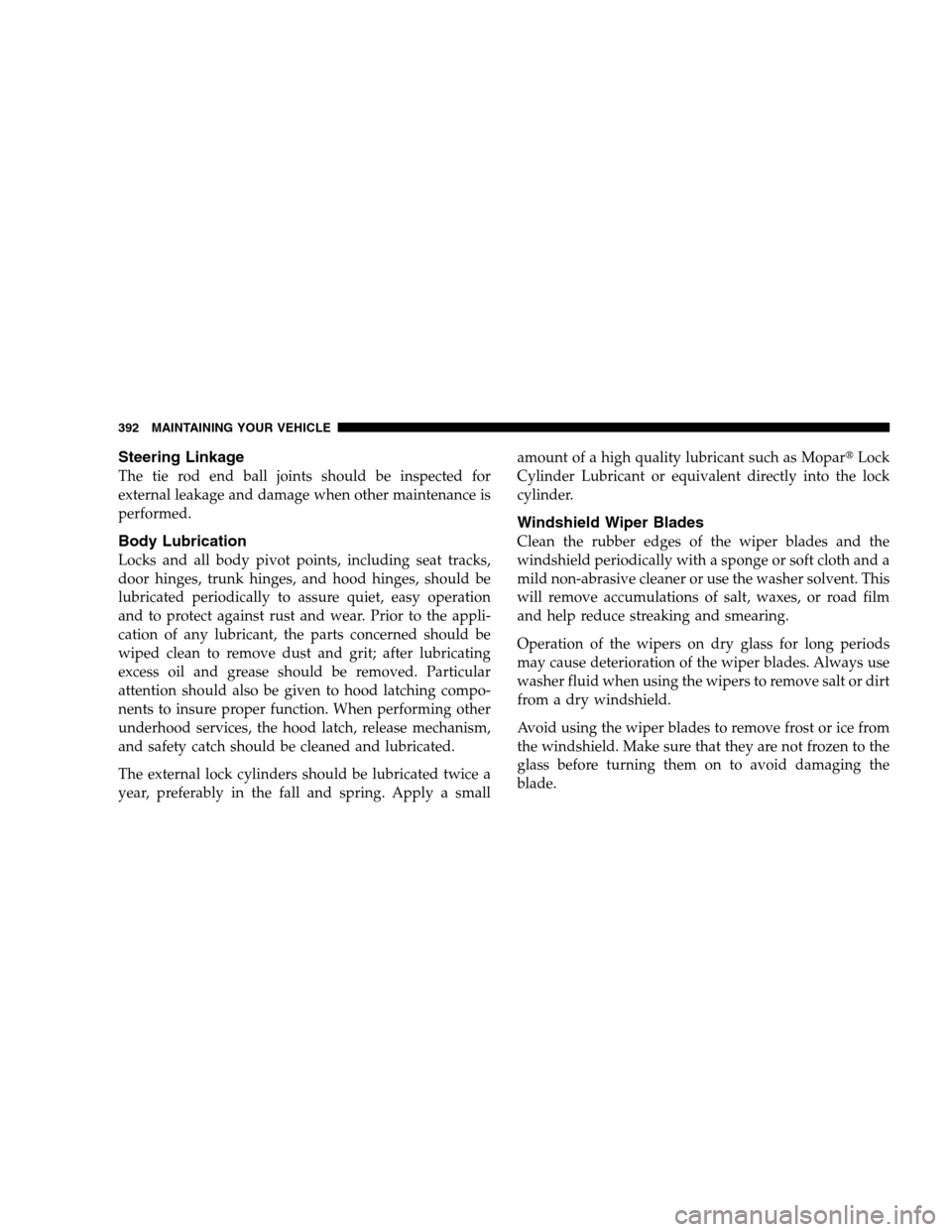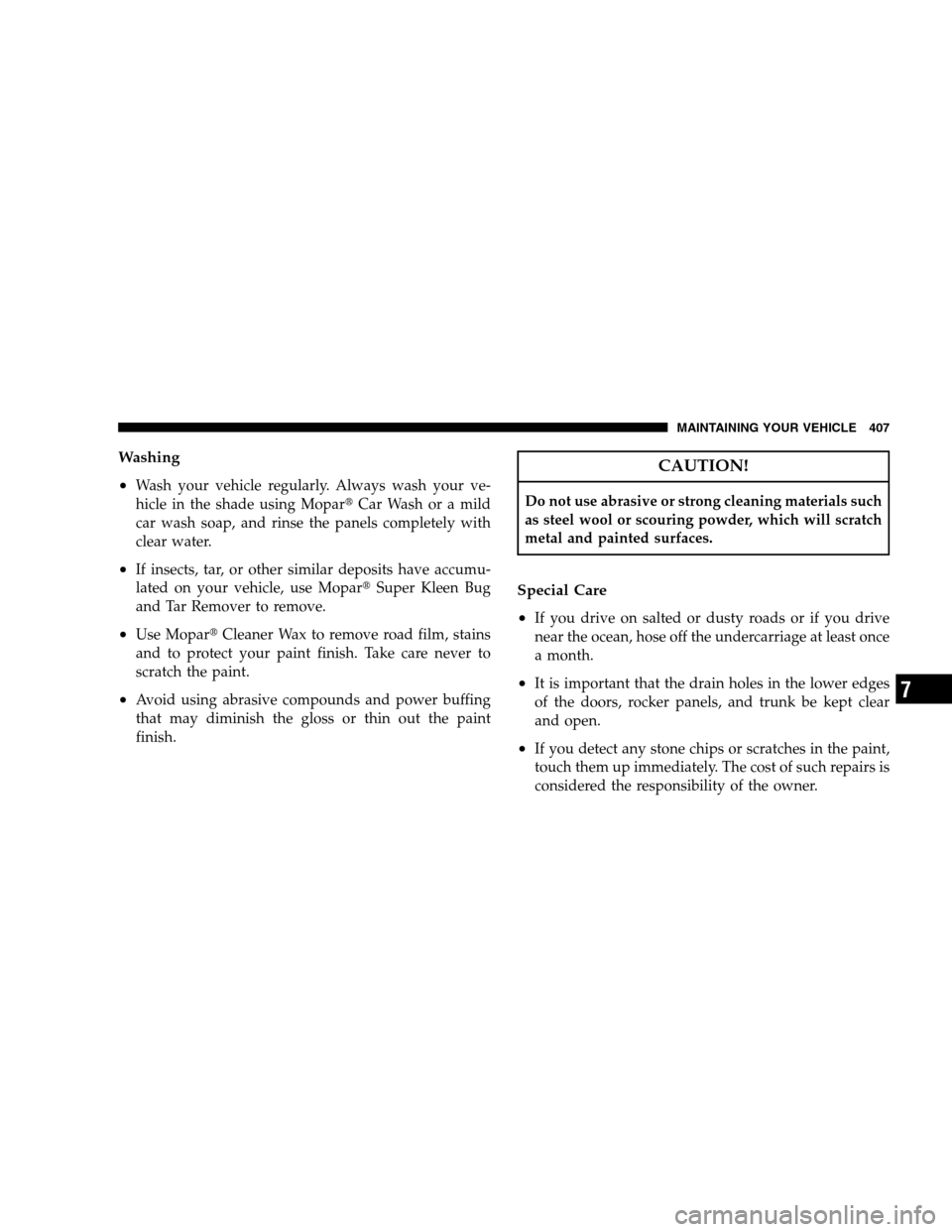Page 329 of 494
Carbon Monoxide Warnings
WARNING!
Carbon monoxide (CO) in exhaust gases is deadly.
Follow the precautions below to prevent carbon
monoxide poisoning:
•Do not inhale exhaust gases. They contain carbon
monoxide, a colorless and odorless gas, which can kill.
Never run the engine in a closed area, such as a
garage, and never sit in a parked vehicle with the
engine running for an extended period. If the vehicle is
stopped in an open area with the engine running for
more than a short period, adjust the ventilation system
to force fresh, outside air into the vehicle.
•Guard against carbon monoxide with proper mainte-
nance. Have the exhaust system inspected every time
the vehicle is raised. Have any abnormal conditions
repaired promptly. Until repaired, drive with all side
windows fully open.
•Keep the trunk closed when driving your vehicle to
prevent carbon monoxide and other poisonous ex-
haust gases from entering the vehicle.
STARTING AND OPERATING 327
5
Page 358 of 494
JACKING AND TIRE CHANGING
WARNING!
•Being under a jacked-up vehicle is dangerous. The
vehicle could slip off the jack and fall on you. You
could be crushed. Never put any part of your body
under a vehicle that is on a jack. Never start or run
the engine while the vehicle is on a jack. If you
need to get under a raised vehicle, take it to a
service center where it can be raised on a lift.
•The jack is designed to use as a tool for changing
tires only. The jack should not be used to lift the
vehicle for service purposes. The vehicle should
be jacked on a firm level surface only. Avoid ice or
slippery areas.
Jack Location
The jack and jack-handle are stowed under the load floor
in the trunk.
Spare Tire Stowage
The compact spare tire is stowed under the rear load floor
in the trunk.
Spare Tire Removal
Lift up the load floor cover and remove the hold down.
356 WHAT TO DO IN EMERGENCIES
Page 394 of 494

Steering Linkage
The tie rod end ball joints should be inspected for
external leakage and damage when other maintenance is
performed.
Body Lubrication
Locks and all body pivot points, including seat tracks,
door hinges, trunk hinges, and hood hinges, should be
lubricated periodically to assure quiet, easy operation
and to protect against rust and wear. Prior to the appli-
cation of any lubricant, the parts concerned should be
wiped clean to remove dust and grit; after lubricating
excess oil and grease should be removed. Particular
attention should also be given to hood latching compo-
nents to insure proper function. When performing other
underhood services, the hood latch, release mechanism,
and safety catch should be cleaned and lubricated.
The external lock cylinders should be lubricated twice a
year, preferably in the fall and spring. Apply a smallamount of a high quality lubricant such as Mopar�Lock
Cylinder Lubricant or equivalent directly into the lock
cylinder.
Windshield Wiper Blades
Clean the rubber edges of the wiper blades and the
windshield periodically with a sponge or soft cloth and a
mild non-abrasive cleaner or use the washer solvent. This
will remove accumulations of salt, waxes, or road film
and help reduce streaking and smearing.
Operation of the wipers on dry glass for long periods
may cause deterioration of the wiper blades. Always use
washer fluid when using the wipers to remove salt or dirt
from a dry windshield.
Avoid using the wiper blades to remove frost or ice from
the windshield. Make sure that they are not frozen to the
glass before turning them on to avoid damaging the
blade.
392 MAINTAINING YOUR VEHICLE
Page 409 of 494

Washing
•
Wash your vehicle regularly. Always wash your ve-
hicle in the shade using Mopar�Car Wash or a mild
car wash soap, and rinse the panels completely with
clear water.
•If insects, tar, or other similar deposits have accumu-
lated on your vehicle, use Mopar�Super Kleen Bug
and Tar Remover to remove.
•Use Mopar�Cleaner Wax to remove road film, stains
and to protect your paint finish. Take care never to
scratch the paint.
•Avoid using abrasive compounds and power buffing
that may diminish the gloss or thin out the paint
finish.
CAUTION!
Do not use abrasive or strong cleaning materials such
as steel wool or scouring powder, which will scratch
metal and painted surfaces.
Special Care
•
If you drive on salted or dusty roads or if you drive
near the ocean, hose off the undercarriage at least once
a month.
•It is important that the drain holes in the lower edges
of the doors, rocker panels, and trunk be kept clear
and open.
•If you detect any stone chips or scratches in the paint,
touch them up immediately. The cost of such repairs is
considered the responsibility of the owner.
MAINTAINING YOUR VEHICLE 407
7
Page 419 of 494

VEHICLE STORAGE
If you will not be using your vehicle for more than 21
days, you may want to take steps to preserve your
battery. You may:
•Disengage the mini-fuse in the Power Distribution
Center labeled IOD (Ignition Off-Draw).
•Or, disconnect the negative cable from the battery.
REPLACEMENT BULBS
All the inside bulbs are brass or glass wedge base.
Aluminum base bulbs are not approved and should not
be used for replacement.
LIGHT BULBS — Interior Bulb Number
Front Courtesy/Reading Lights..........578/W5W
Center Courtesy/Reading Lights.........578/W5W
Visor Vanity Lights.....................A6220
Glove Box Light......................... 194LIGHT BULBS — Interior Bulb Number
Shift Indicator Light................. JKLE14140
Rear Compartment (Trunk) Light............. 579
NOTE:For lighted switches, see your dealer for replace-
ment instructions.
LIGHTS BULBS — Outside Bulb No.
Low Beam Headlight.....................9006
High Beam Headlight.....................9005
Front Park/Turn Signal/Side Marker Light. . . 3157AK
Front Fog Light.....................9145//H10
Center High Mounted Stop Light
(CHMSL)........................ W16W(921)
Rear Tail/Stop.........................3157K
Decklid Tail Light....................... T3.25
Rear Turn Signal......................3157AK
Backup Light..........................3157K
License Light........................... 168
MAINTAINING YOUR VEHICLE 417
7
Page 426 of 494
Tail/Stop Light, Rear Turn Signal Light, Backup
Light
The taillights are a two piece design. The turn signal,
brake and taillights are located in the rear corner body
panel housing. The back up and taillights are located in
the trunk lid housing.
Changing the Tail/Stop Light or Rear Turn Signal
Light
1. Open the trunk and gently pull back the trunk liner
behind the tail lamp
Split Taillight Assembly
Pull Back Trunk Liner
424 MAINTAINING YOUR VEHICLE
Page 428 of 494
5. Remove the bulb from the connector socket and install
the replacement bulb.
6. Install the bulb and connector assembly into the
taillight housing and rotate the connector one-quarter
turn clockwise to lock it in place.
7. Reinstall the taillight housing.
Changing the Backup Light
1. Open the trunk.
2. Rotate the bulb’s electrical connector one-quarter turn
counterclockwise and remove it from the housing.
Backup and Rear Fog Light
1 — Rear Fog Light
2 — Backup Light 426 MAINTAINING YOUR VEHICLE
Page 430 of 494
Center High-Mounted Stop Light (CHMSL)
1. Open the trunk lid.
2. Rotate the bulb’s electrical connector one-quarter turn
counterclockwise and remove it from the CHMSL hous-
ing.3. Remove the bulb from the connector socket and install
the replacement bulb.
4. Install the bulb and connector assembly into the
CHMSL housing and rotate the connector one-quarter
turn clockwise to lock it in place.
High-mounted Stop Light Bulb Replacement
428 MAINTAINING YOUR VEHICLE